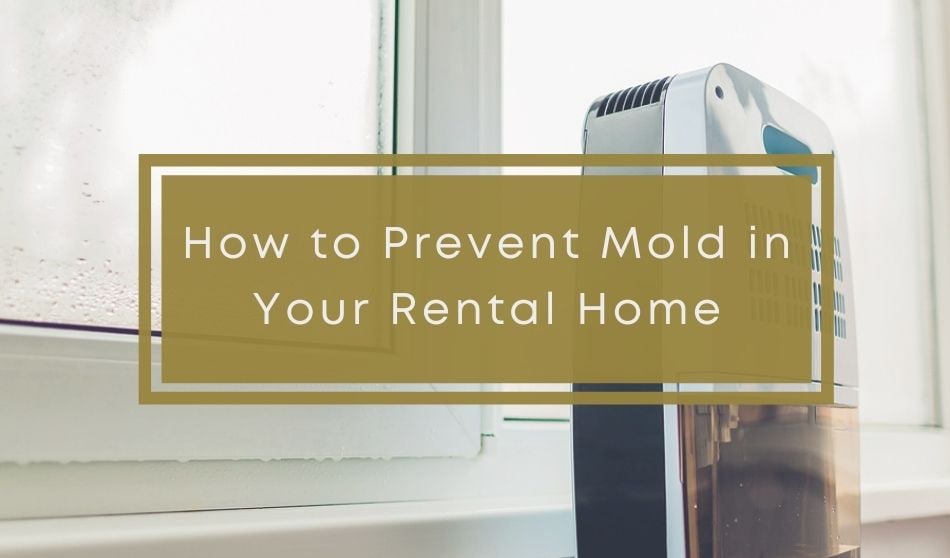
The presence of mold in your rental home can be anything from a nuisance to a large health hazard. While not all mold is hazardous, the more that any mold is allowed to grow, the more it risks damaging your property and disrupts the clean air you used to have in your rental.
If you have noticed mold growing in your rental home in the past, whether you are a tenant or a landlord, it’s important to understand a landlord’s responsibility for mold before addressing the problem. Once any mold has been removed, this guide to help you learn about the options you have when it comes to preventing future mold in your rental.
Where Does Mold Grow?
The first thing you must confirm is where mold grows or thrives in your rental. Understanding this makes it easier for you to direct the mold prevention actions to those areas.
Mold grows for many reasons, including excess moisture and inappropriate heating in the home.
That said, here are some of the places you should look for mold in your home:
- Mold grows on clothes that weren’t properly rinsed.
- Left-over foods can attract mold.
- Mold can grow in parts of the home or apartment that are susceptible to ventilation and moisture issues.
How Can I Prevent Mold in My Home?
Learning to prevent mold may seem challenging, but thankfully it’s not rocket science. Moisture is one of the major causes of mold growth in the home. Whether you rent or own a rental property, these helpful tips will help you prevent mold in the rental.
Tenants Can Prevent Mold in the Rental Home by Reducing Moisture:
Renters should keep this have this in mind throughout daily life. If you are a renter, ensure that your health, security deposit, and your belongings are protected by preventing mold-inducing moisture within the rental. Unconsciously, renters can aid mold growth through simple acts like leaving wet clothes on furniture, leaving the windows open on humid days, not using exhaust fans in bathrooms or kitchens. Here are some easy habits renters must get into to prevent mold in the rental.
Keep Doors Closed
The truth is that leaving your doors open will do more harm than good. The reason is that moisture can travel from the major concentrated spot to the other unaffected parts of the home when the door is open. These instances are examples of why you need to start shutting your doors more often:
- Shut the doors of your kitchen when cooking because the excess moisture in the room (kitchen) tends to escape and travel into other parts of your home.
- Consider shutting your bathroom door when bathing so the excess moisture generated from your bath will be confined (allowing the moisture to be reduced by the exhaust fan).
Take Care of Your Bathroom
You already know that your bathroom is one of the top zones for excess moisture. Take care of your bathroom so you will prevent mold from growing.
- Vent out Moisture when Bathing: It is no news that excess moisture is present when you are bathing. Vent that moisture out. If you do not currently have a fan in your bathroom, the best bet on venting out moisture when bathing is to open a window if the weather allows.
- Wipe Your Bathroom Walls: Moisture can build up in the walls of your bathroom. The potential causes are soap studs and water from your body that splash on the walls. A good rule of thumb is to wipe down the walls of your bathroom and tub after your shower or bath. Doing that helps in wiping off the moisture that might be sitting on the walls of your bathroom.
Keep Away Wet Clothes
When you fail to fully dry your clothes after washing, you will be indirectly inviting mold. The same happens when leave dirty and damp clothes or towels inside your room.
- Wash and dry damp items immediately, don’t allow them to settle in your hamper or the floor.
- Whenever possible, avoid air-drying clothes indoors. In areas where there is little or no ventilation to facilitate proper circulation, air-drying clothes could trigger mold growth when the moisture evaporates and settles on the ceiling.
Landlords Have Many Tools They Can Utilize to Reduce Humidity and Prevent Mold in the Rental:
Landlords may not be able to improve their tenants’ daily habits, but you do have many options to select from when it comes to reducing humidity in your home as a way of preventing mold from growing. These tricks can be useful to ensure that mold does not grow with your rental.
Use a Dehumidifier
A dehumidifier is an excellent solution to moisture problems. These units serve to drastically reduce the humidity levels in a room. Be sure to install a dehumidifier after you must have sought the professional advice of your local home appliance supplier to find the best unit for your needs.
Install a Hygrometer
Changes in temperature within a building are easy to sense- there’s no doubt you know when your body becomes colder. However, you may not know if the humidity levels are increasing or not. That is why you must install a hygrometer to help you with that function. A hygrometer is a device that keeps tabs and deciphers the humidity levels in your home. With the installation, it becomes easier for you to know when the humidity levels are increasing.
According to the EPA, mold can grow if humidity levels are not kept below 60 percent, and your ideal humidity range is between 30 percent and 50 percent. Ensuring proper humidity levels can also serve to discourage pests like cockroaches and dust mites. Keep an eye on your installed hygrometer to know when it gets to that point.
Consider Installing Exhaust Fans
Kitchens and bathrooms are veritable hot spots for mold to grow. Excess moisture thrives there, especially when occupants are cooking or bathing.
Since the risks of mold growth in the kitchen are high, ensure that cooking spaces are equipped with exhaust fans. Installing kitchen hoods will also be ideal, as they help to suck up moisture and grease when you are cooking. Similarly, ensure that you have adequate exhaust fans in bathrooms to ensure that your tenants’ morning showers aren’t doing permanent damage to the rental by causing mold growth.
Detect Leaks Quickly and Check for Leaks During Inspections
If you have detected excess moisture in the rental home – it makes sense to check for leaks in your kitchen or bathrooms. Household appliances might be leaking without your (or your tenant’s) knowledge. When that happens, excess moisture will settle in the walls and flooring or pool around the leak. This causes expensive damage to the unit and serves as an excellent catalyst for mold and mildew growth.
Unfortunately for landlords, it is only when you figure out when leaks are occurring that you will find the best way to address the excess moisture. While your tenants are likely to notice and report a large leak from a burst pipe, they may not be aware of the significance of a steady drip under the kitchen sink. Regular inspections can be vital for this reason, be sure to regularly check for leaks, and remind your tenants to submit a maintenance request whenever they notice even a small leak occurring. In addition to regular inspections, you can install a smart leak detector to get regular updates if there is a leak.
Here are some common spots where undetected leaks can occur:
- Check under sinks and dishwashers
- Beneath the radiators or heat pumps
- Check around washing machine and toilet
Final Words
Mold can be a costly problem for your health and your pocketbook. Preventing mold in your rental home is a matter of knowing what to do – a few helpful habits can go a long way to ensuring that your rental is mold-free. Whether you are a tenant or a landlord, you are now in a better position to put down your foot and stop mold growth in your rental.
This article was originally published in September 2020 and has since been updated.




